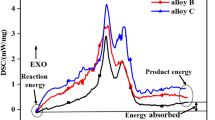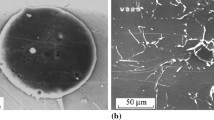Abstract
In this study, 25 wt% Ni(Cr)–75 wt% Cr3C2 powder was thermally sprayed onto 304 stainless steel substrate to produce coatings of ~400-µm thick and the oxidation behaviour of the coatings was investigated. The kinetic behaviour of oxidation of freestanding coatings was investigated over short times at 650, 700 and 800 °C using the thermogravimetric analysis technique. The oxidation rate for all samples was parabolic in nature and the parabolic rate constant (k) increased with increasing temperature. The activation energy (Q) for oxidation was found to be around 226 kJ mol−1. Furnace oxidation tests were also carried out on the as-sprayed samples at 700 and 800 °C in laboratory air for times ranging from 1 h up to 16 days (384 h). The oxide scale growth, morphology and phase formation were investigated using scanning electron microscopy, energy dispersive X-ray analysis and X-ray diffraction. An oxide scale covered the surface of the cermet coating following oxidation at both 700 and 800 °C; the scale was significantly thicker at the higher temperature. It was found to be Cr2O3 and it covered both the metal matrix and the Cr3C2 particles present in the coating. The oxide grains had an angular shape after 16 days of exposure at both temperatures but the grain size was significantly larger after exposure at 800 °C.










Similar content being viewed by others
References
Skea J, Ekins P, Winskel M (2011) Energy 2050: making the transition to a secure low carbon energy system. Earthscan, London
Henry J, Zhou G, Ward T (2007) Lessons from the past: materials-related issues in an ultra-supercritical boiler at Eddystone plant. Mater High Temp 24:249–258
Natesan K, Park JH (2007) Fireside and steamside corrosion of alloys for USC plants. Int J Hydrog Energ 32:3689–3697
Tillman DA (2000) Biomass cofiring: the technology, the experience, the combustion consequences. Biomass Bioenerg 19:365–384
Simms NJ, Sumner J, Hussain T, Oakey JE (2013) Fireside issues in advanced power generation systems. Mater Sci Tech 29:804–812
Sundararajan T, Kuroda S, Itagaki T, Abe F (2013) Steam oxidation resistance of NiCr thermal spray coatings on 9Cr-1Mo Steel. Part 1. ISIJ Int 43:95–103
Kunioshi CT, Correa OV, Ramanathan LV (2006) High temperature oxidation and erosion–oxidation behaviour of HVOF sprayed Ni–20Cr, WC–20Cr–7Ni and Cr3C2–Ni–20Cr coatings. Surf Eng 22:121–127
Wang B, Shui ZR (2002) The hot erosion behaviour of HVOF chromium carbide—metal cermet coatings sprayed with different powders. Wear 253:550–557
Wang B, Luer K (1994) The erosion oxidation behaviour or HVOF Cr3C2-NiCr cermet coating. Wear 174:177–185
Matthews SJ, James BJ, Hyland MM (2007) Microstructural influence on erosion behaviour of thermal spray coatings. Mater Charact 58:59–64
Matthews S, James B, Hyland M (2009) The role of microstructure in the mechanism of high velocity erosion of Cr3C2–NiCr thermal spray coatings: Part 2—Heat treated coatings. Surf Coat Tech 203:1094–1100
Matthews S, James B, Hyland M (2009) High temperature erosion of Cr3C2–NiCr thermal spray coatings—the role of phase microstructure. Surf Coat Tech 203:1144–1153
Quets JM, Walsh PN, Sirinwasan V, Tucker RC (1994) The high temperature characterisation of erosion resistant detonation gun chromium carbide coating. Surf Coat Tech 68(69):99–105
Sidhu TS, Prakash S, Agrawal RD (2006) Hot corrosion studies of HVOF sprayed Cr3C2-NiCr and Ni-20Cr coatings on nickel based superalloys at 900 °C. Surf Coat Tech 201:792–800
Kamal S, Jayaganthan KF, Prakash S (2009) Evaluation of cyclic hot corrosion behaviour of detonation gun sprayed Cr3C2–25% NiCr coatings on Ni- and Fe- based superalloys. Surf Coat Tech 203:1004–1013
Kaur M, Singh H, Prakash S (2012) High temperature behaviour of a HVOF sprayed Cr3C2-NiCr coating. Metall Mater Trans A 43A:2979–2992
Kamal S, Jayaganthan R, Prakash S (2009) High temperature oxidation studies of detonation-gun-sprayed Cr3C2–NiCr coating on Fe- and Ni-based superalloys in air under cyclic conditions at 900°C. J Alloy Compd 472:378–389
Ye FX, Wu SH, Ohmori A (2008) Microstructure and oxidation behavior of Cr39Ni7C cermet coatings deposited by diamond jet spray process. J Therm Spray Techn 17:942–947
Berger LM, Vuoristo P, Mantyla T, Gruner W (1998) A study of oxidation behaviour of WC-Co, Cr3C2-NiCr and TiC-Ni-based materials in thermal spray processes. In: Proceedings 15th International Thermal Spray Conference, 25–29 May 1998, Nice, pp 75–82
Matthews S, James B, Hyland M (2008) Erosion of oxide scales formed on Cr3C2-NiCr thermal spray coatings. Corros Sci 50:3087–3094
Matthews S, James B, Hyland M (2010) The effect of heat treatment on the oxidation mechanism of blended powder Cr3C2-NiCr coatings. J Therm Spray Technol 19:119–127
Guilemany JM, Nutting J, Llorca-Isern N (1994) Characterisation of Cr3C2-NiCr cermet powder for high velocity oxyfuel spraying. Powder Metall 37:289–292
Poirer D, Legoux JG, Lima RS (2013) Engineering HVOF sprayed Cr3C2-NiCr coatings: the effect of particle morphology and spraying parameters. J Therm Spray Techn 22:280–289
Zimmermann S, Kreye H (1996) Chromium Carbide coatings produced with various HVOF Spray Systems. In: Proceedings of the 9th National Thermal Spray Conference, ASM International, Materials Park. pp 147–152
Guilemany JM, Nutting J, Llorca-Isern N (1996) Microstructural examination of HVOF chromium carbide coatings for high-temperature applications. J Therm Spray Technol 5:483–489
Guilemany JM, Calero JA (1997) Structural characterization of chromium carbide nickel chromium coatings obtained by HVOF-spraying. In: Berndt CC (ed) Thermal spray: a united forum for scientific and technological advances. ASM International, Materials Park, pp 717–721
Wirojanupatump S, Shipway PH, McCartney DG (2001) The influence of HVOF powder feedstock characteristics on the abrasive wear behaviour of CrxCy–NiCr coatings. Wear 249:829–837
He J, Ice M, Lavernia E (2000) Synthesis of nanostructured Cr3C2-25(Ni20Cr) coatings. Metall Mater Trans A 31:555–564
Birks N, Meier GH, Pettit FS (2006) Introduction to the high-temperature oxidation of metals, 2nd edn. CUP, Cambridge
Matthews S, Hyland M, James B (2003) Microhardness variation in relation to carbide development in heat treated Cr3C2–NiCr thermal spray coatings. Acta Mater 51:4267–4277
Suegama PH, Espallargas N, Guilemany JM, Fernandez J, Benedetti AV (2006) Electrochemical and structural characterization of heat treated Cr3C2-NiCr coatings. J Electrochem Soc 153:B434–B445
Natali-Sora I, Mor F, La Vecchia GM, Zocchi M (1998) Structural Changes in high velocity oxy fuel sprayed Cr3C2/NiCr 75/25 coatings after annealing treatments. Mater Sci Forum 278–281:520–525
Guilemany JM, Miguel JM, Vizcaino S, Lorenzana C, Delgado J, Sanchez J (2002) Role of heat treatments in the improvement of the sliding wear properties of Cr3C2-NiCr coatings. Surf Coat Tech 157:207–213
He J, Lavernia E (2001) Precipitation phenomena in nanostructured Cr3C2-NiCr coatings. Mater Sci Engr A301:69–79
Brandes EA, Brook GB (1998) Smithells metals reference book, 7th edn. Butterworth-Heinemann, Oxford, pp 11–215
Velikanova TYa, Bondar AA, Grytsiv AV (1999) The chromium-nickel-carbon (Cr-Ni-C) phase diagram. J Phase Equilib 20:125–146
Wirojanupatump S (1999) Characterisation and wear performance of HVOF sprayed CrxCy coatings, PhD thesis, University of Nottingham, Nottingham, UK
Li C-J, Ji G-C, Wang Y-Y, Sonoya K (2002) Dominant effect of carbide rebounding on the carbon loss during high velocity oxy-fuel spraying of Cr3C2-NiCr. Thin Solid Films 419:137–143
Calvarin G, Molins R, Huntz AM (2000) Oxidation mechanism of Ni—20Cr foils and its relation to the oxide-scale microstructure. Oxid Met 53:25–48
Berthod P (2007) Influence of chromium carbides on the high temperature oxidation behavior and on chromium diffusion in nickel-base alloys. Oxid Met 68:77–96
Kofstad P (1966) High-temperature oxidation of metals, 1st edn. Wiley, New York
Khanna AS (2002) Introduction to high temperature oxidation and corrosion, 1st edn. ASM International, Materials Park
Stringer J, Wilcox BA, Jaffee RI (1972) The high-temperature oxidation of nickel-20 wt. % chromium alloys containing dispersed oxide phases. Oxid Met 5:11–47
Ul-Hamid A (2004) A TEM study of the oxide scale development in Ni-Cr alloys. Anti-Corros Method M 51:216–222
Durham R, Gleeson B, Young DJ (1998) Silicon contamination effects in the oxidation of carbide-containing cobalt-chromium alloys. Mater Corros 49:855–863
Durham RN, Gleeson B, Young DJ (1998) Factors affecting chromium carbide precipitate dissolution during alloy oxidation. Oxid Met 50:139–165
Clark JN, Glasson DR, Jayaweera SAA (1986) Oxidation of chromium carbide. Thermochim Acta 103:193–199
Kofstad P, Lillerud KP (1980) On high temperature oxidation of chromium: II. Properties of and the oxidation mechanism of chromium. J Electrochem Soc 127:2410–2419
Lillerud KP, Kofstad P (1980) On high temperature oxidation of chromium: I. Oxidation of annealed, thermally etched chromium at 800°–1100°C. J Electrochem Soc 127:2397–2410
Tsai SC, Huntz AM, Dolin C (1996) Growth mechanism of Cr2O3 scales: oxygen and chromium diffusion, oxidation kinetics and effect of yttrium. Mater Sci Eng 212:6–13
Matthews S, James B, Hyland M (2013) High temperature erosion-oxidation of Cr3C2-NiCr thermal spray coatings under simulated turbine conditions. Corros Sci 70:203–211
Acknowledgements
The authors would like to thank the technical staff in the Division of Materials, Mechanics and Structure Division at the Faculty of Engineering, University of Nottingham, specifically Dr. Deen Zhang and Mr. Rory Screaton for help with thermal spraying and Mr. Keith Dinsdale for his help with the TGA experiments.
Author information
Authors and Affiliations
Corresponding author
Ethics declarations
Conflict of interest
The authors declare that they have no conflict of interest.
Rights and permissions
About this article
Cite this article
Ding, Y., Hussain, T. & McCartney, D.G. High-temperature oxidation of HVOF thermally sprayed NiCr–Cr3C2 coatings: microstructure and kinetics. J Mater Sci 50, 6808–6821 (2015). https://doi.org/10.1007/s10853-015-9238-z
Received:
Accepted:
Published:
Issue Date:
DOI: https://doi.org/10.1007/s10853-015-9238-z




